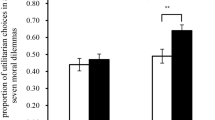Abstract
Does using a foreign language result in forming different moral decisions than using our mother tongue? Two studies were conducted to investigate whether there is a relationship between foreign language effects (differences between native vs. foreign language conditions) and psychological distance. Study 1 tested four moral dilemmas adapted from Greene et al. (Cognition 107: 1144–1155, 2008). Non-fluent Korean–English bilingual participants (N = 161) indicated decisions regarding four moral dilemmas in either Korean or English languages. The study found that for personal moral conflict situations, in which emotion and automatic intuition were more important than deliberation, there were significant differences in ratios of utilitarian decisions between the native language (L1) and the foreign language (L2) conditions. The participants tended to make more utilitarian decisions in L2 than in L1, which implies reduced emotionality in L2. Study 2 examined whether the psychological distance increased using the foreign language (English) utilizing an automatic self-test. Nonproficient Korean–English bilinguals (N = 26) formed associations between three kinds of geometric shapes (ellipses, rectangles and triangles) and three kinds of labels (‘me’, ‘friends’ and ‘others’). The results of the study found the self-bias effect decreased when labels were presented in the foreign language (in English). This implies that the foreign language effect resulted from the reduced emotional response, and deliberation in decision making which may result from increased psychological distance.


Similar content being viewed by others
Notes
Caldwell-Harris (2014) suggested that the stronger emotionality in L1 is associated with the acquisition and the use in the emotional context (i.e., family). However, if someone uses L1 primarily at work, a lower level of emotionality in L1might be experienced. Therefore it plays a critical role for the emotionality for L1, whether L1 is learned and used in the emotional context. Pavlenko (2008) explained that different emotionality between L1 and L2 is based on age, context of L2 acquisition and language dominance. Therefore early balanced bilinguals, whose L1 is no longer dominant, might show weaker emotional response in L1 than late relatively unbalanced bilinguals.
There is variability in experimental studies regarding emotional differences between languages (Pavlenko 2008). For example, Harris et al. (2003) showed that skin conductance responses (SCRs) of late Turkish–English bilinguals were stronger to L1 than to L2. However early relatively balanced Turkish–English bilinguals showed similar SCRs in L1 and L2. Therefore there might be interactions between age and context of L2 acquisition regarding emotionality and languages.
The participants had a lower level of proficiency in speaking and writing than in listening. The result might imply that the acquisition of L2 was not related to various context. Pavlenko (2008) mentioned that speaking and writing is primarily associated with emotional context. Therefore the lower proficiency in speaking and writing might implicate that the participants not so often learned L2 and used it in emotional context.
References
Amit, E., & Greene, J. D. (2012). You see, the ends don’t justify the means: Visual imagery and moral judgment. Psychological Science, 23, 861–868.
Caldwell-Harris, C. L. (2008). Language research needs an “emotion revolution” AND distributed models of the lexicon. Bilingualism: Language and Cognition, 12, 291–303.
Caldwell-Harris, C. L., & Ayçiçeği-Dinn, A. (2009). Emotion and lying in a non-native language. International Journal of Psychophysiology, 71, 193–204.
Caldwell-Harris, C. L. (2014). Emotionality differences between a native and foreign language: Theoretical implications. Frontiers in Psychology: Language Science, in press.
Conway, P., & Gawronski, B. (2013). Deontological and utilitarian decisions in moral decision making. Journal of Personality and Social Psychology, 104, 216–235.
Costa, A., Foucart, A., Arnon, I., Aparici, M., & Apesteguia, J. (2014). “Piensa” twice: On the foreign language effect in decision making. Cognition, 130, 236–254.
Costa, A., Foucart, A., Arnon, I., Aparici, M., & Apesteguia, J. (2015). Corrigendum to “Piensa” twice: On the foreign language effect in decision making. Cognition, 142, 362–363.
Duñabeitia, J. A., & Costa, A. (2015). Lying in a native and foreign language. Psychonomic Bulletin & Review, 22, 1124–1129.
Eyal, T., Liberman, N., & Trope, Y. (2008). Judging near and distant virtue and vice. Journal of Experimental Psychology, 44, 1204–1209.
Geipel, J., Hadjichiristidis, C., & Surian, L. (2015). The foreign language effect on moral judgment: The role of emotions and norms. Plos ONE, 10, e0131529.
Gong, H., & Medin, D. L. (2012). Construal levels and moral judgment: Some implications. Judgment and Decision Making, 7, 628–638.
Graham, J., Haidt, J., & Nosek, B. A. (2009). Liberals and conservatives rely on different sets of moral foundations. Personality Process and Individual Differences, 96, 1029–1046.
Greene, J. D., Sommerville, R. B., Nystrom, L. E., Darley, J. M., & Cohen, J. D. (2001). An fMRI investigation of emotional engagement in moral judgement. Science, 293, 2105–2108.
Greene, J. D. (2003). From neural to moral ought: What are the moral implications of neuroscientific moral psychology? Nature Reviews Neuroscience, 4, 847–850.
Greene, J. D., Morelli, S. A., Lowenberg, K., Nystrom, L. E., & Cohen, J. D. (2008). Cognitive load selectively interferes with utilitarian moral judgment. Cognition, 107, 1144–1155.
Greene, J. D. (2009). Dual-process morality and the personal/impersonal distinction: A reply to McGuire, Langdon, Coltheart, and Mackenzie. Journal of Experimental Social Psychology, 45, 581–584.
Greene, J. D., Cushman, F. A., Stewart, L. E., Lowenberg, K., Nystrom, L. E., & Cohen, J. D. (2009). Pushing moral buttons: The interaction between personal force and intention in moral judgment. Cognition, 111, 364–371.
Haidt, J. (2001). The emotional dog and its rational tail: A social intuitionist approach to moral judgment. Psychological Review, 108, 814–834.
Harris, C. L., Ayçiçe\(\hat{\rm g}\)i, A., & Gleason, J. B. (2003). Taboo words and reprimands elicit greater autonomic reactivity in a first language than in a second language. Applied Psycholinguistics, 24, 561–579.
Ijzerman, H., & Semin, G. R. (2010). The thermometer of social relations: Mapping social proximity on temperature. Psychological Science, 20, 1214–1219.
Ivaz, L., Costa, A., & Dunabeitia, J. A. (2016). The emotional impact of being myself: Emotions and foreign-language processing. Journal of Experimental Psychology: Learning, Memory, and Cognition, 42, 489–496.
Kahneman, D. (2003). A perspective on judgment and choice: Mapping bounded rationality. American Psychologist, 58, 697–720.
Kesebir, S., & Oishi, S. (2010). A spontaneous self-reference effect in memory: Why some birthdays are harder to remember than others. Psychological Science, 21, 1525–1531.
Keysar, B., Hayakawa, S. L., & An, S. G. (2012). The foreign-language effect: Thinking in a foreign tongue reduces decision biases. Psychological Science, 23, 661–668.
Liberman, N., Trope, Y., & Stephan, E. (2007). Psychological distance. In E. T. Higgins & A. W. Kruglanski (Eds.), Social psychology: A handbook of basic principles (pp. 353–381). New York: Guilford Press.
Marian, V., & Neisser, U. (2000). Language-dependent recall of autobiographical memories. Journal of Experimental Psychology: General, 129, 361–368.
Pavlenko, A. (2008). Emotion and emotion-laden words in the bilingual lexicon. Bilingualism: Language and Cognition, 11, 147–164.
Pavlenko, A. (Ed.). (2006). Bilingual minds: Emotional experience, expression, and representation. Clevedon: Multilingual Matters.
Putoni, S., De Langhe, B., & Van Osselar, S. M. J. (2009). Bilingualism and the emotional intensity of advertising language. Journal of Consumer Research, 35, 1012–1025.
Rogers, T. B., Kuiper, N. A., & Kirker, W. S. (1977). Self-reference and the encoding of personal information. Journal of Personality and Social Psychology, 35, 677–688.
Semin, G., & Fiedler, K. (1988). The cognitive functions of linguistic categories in describing persons: Social cognition and language. Journal of Personality and Social Psychology, 54, 558–568.
Sui, J., He, X., & Humphreys, G. W. (2012). Perceptual effects of social salience: Evidence from self-prioritization effects on perceptual matching. Journal of Experimental Psychology: Human Perception and Performance, 38, 1105–1117.
Sui, J., Sun, Y., Peng, K., & Humphreys, G. W. (2014). The automatic and the expected self: Separating self- and familiarity biases effects by manipulating stimulus probability. Attention, Perception, & Psychophysics, 76, 1176–1184.
Trope, Y., & Liberman, N. (2010). Construal-level theory of psychological distance. Psychological Review, 117, 440–463.
Turk, D. J., Cunningham, S. J., & Macrae, C. N. (2008). Self-memory biases in explicit and incidental encoding of trait adjectives. Consciousness and Cognition, 17, 1040–1045.
Wu, S., Barr, D. J., Gann, T. M., & Keysar, B. (2013). How culture influences perspective taking: Differences in correction, not integration. Frontiers in Human Neuroscience, 7, 822.
Acknowledgements
This work was supported by the Ministry of Education of the Republic of Korea and the National Research Foundation of Korea (NRF-2015S1A5A8011028). The authors declare that they have no conflict of interest.
Author information
Authors and Affiliations
Corresponding author
Appendix A.
Appendix A.
Moral dilemmas in Study 1 (English and Korean Version)
Impersonal dilemmas
Fumes
You are the night guard at a hospital. Due to an accident in the building next door, there are deadly fumes rising up through the hospital. There are three patients in one room of the hospital. There is a single patient in another room. If you do nothing, the fumes will rise up into the room containing the three patients and cause their deaths. The only way to avoid the deaths of these patients is to hit a certain switch, which will cause the fumes to bypass the room containing the three patients. This will result in the fumes entering the room containing the single patient and causing his death. Is it appropriate for you to hit the switch in order to avoid the deaths of the three patients?
Trolley


Personal dilemmas
Crying baby
Enemy soldiers have taken over your village. They have orders to kill all remaining civilians. You and some of your townspeople have sought refuge in the cellar of a large house. Outside you hear the voices of soldiers who have come to search the house for valuables. Your baby begins to cry loudly. You cover his mouth to block the sound. To save yourself and the others you must suffocate your child. Is it appropriate for you to smother your child in order to save yourself and the other townspeople?
Transplant


Rights and permissions
About this article
Cite this article
Shin, H.I., Kim, J. Foreign Language Effect and Psychological Distance. J Psycholinguist Res 46, 1339–1352 (2017). https://doi.org/10.1007/s10936-017-9498-7
Published:
Issue Date:
DOI: https://doi.org/10.1007/s10936-017-9498-7




